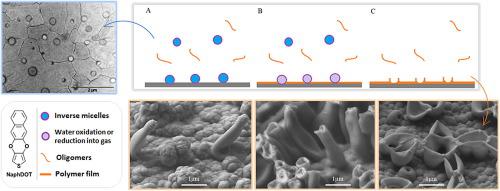Journal of Colloid and Interface Science ( IF 9.4 ) Pub Date : 2021-01-20 , DOI: 10.1016/j.jcis.2021.01.038 Caroline Fradin , François Orange , Sonia Amigoni , Caroline R. Szczepanski , Frédéric Guittard , Thierry Darmanin

|
Hypothesis
The formation of porous nanostructures on surfaces and the control of their size and shape is fundamental for various applications. The creation of nanotubes is particularly difficult to implement without the aid of hard and rigid templates. Recently, methods that form nanotubular structures in a straightforward manner and without direct templating, e.g. soft templating, have been highly sought after. Here we propose the use of “soft templating” via self-assembly of conducting monomers during electropolymerization in organic solvents as a mean to form porous, nanotubular features.
Experiments
Naphtho[2,3-b]thieno[3,4-e][1,4]dioxine (NaphDOT) is employed as monomer for electropolymerizations conducted in dichloromethane and chloroform containing varying amounts of water. SEM analyses of the resulting surfaces confirms the strong capacity of NaphDOT to form vertically aligned nanotubes. Polymerization solutions analyzed by DLS and TEM reveal the presence of micelles prior to electropolymerization, and the size of the micelles correlates with the inner diameter of the nanotubes formed.
Findings
We show that micelles in polymerization solutions are stabilized by both monomers and electrolytes. We propose a mechanism where reverse micelles are forming a soft-template responsible for the formation of porous nanostructures during electropolymerization in organic, non-polar solvents. In this mechanism, the monomer and electrolyte assume the role of surfactant in the reverse micelle system.
中文翻译:

在有机溶剂中通过软模板电聚合形成胶束
假设
对于各种应用而言,在表面上形成多孔纳米结构以及控制其尺寸和形状至关重要。如果没有硬模板和硬模板的帮助,纳米管的创建尤其难以实现。近来,已经强烈寻求以直接的方式并且没有直接模板化例如软模板化的方式形成纳米管结构的方法。在这里,我们提出通过在有机溶剂中进行电聚合过程中导电单体的自组装,使用“软模板”作为形成多孔纳米管特征的手段。
实验
萘并[2,3- b ]噻吩并[3,4-e] [1,4]二恶英(NaphDOT)被用作在含不同水量的二氯甲烷和氯仿中进行电聚合的单体。所得表面的SEM分析证实了NaphDOT形成垂直排列的纳米管的强大能力。通过DLS和TEM分析的聚合溶液揭示了电聚合之前胶束的存在,并且胶束的尺寸与所形成的纳米管的内径相关。
发现
我们表明,聚合溶液中的胶束被单体和电解质所稳定。我们提出了一种机制,其中反胶束正在形成一个软模板,该模板负责在有机非极性溶剂中进行电聚合过程中形成多孔纳米结构。在这种机理下,单体和电解质在反胶束体系中承担表面活性剂的作用。











































 京公网安备 11010802027423号
京公网安备 11010802027423号